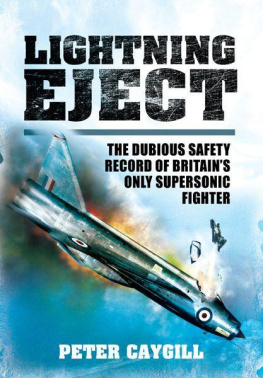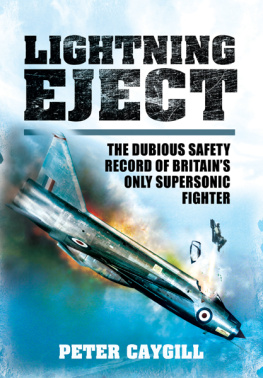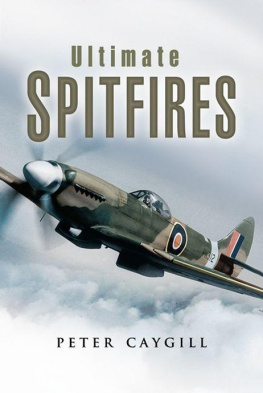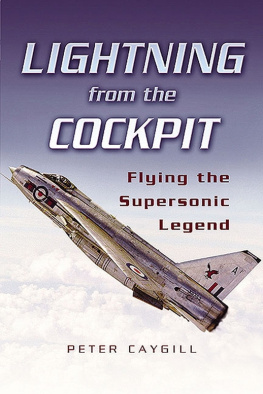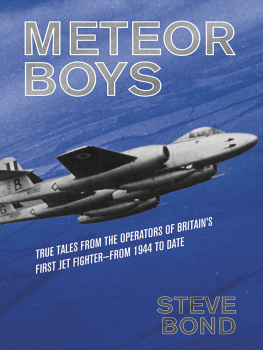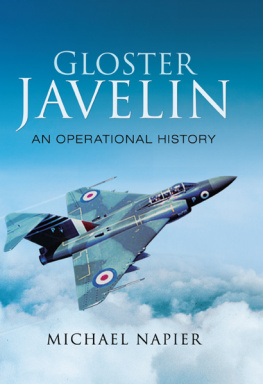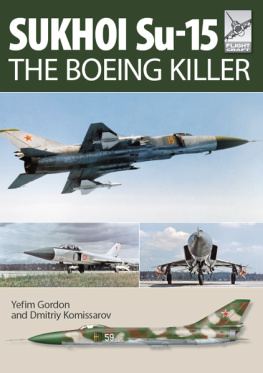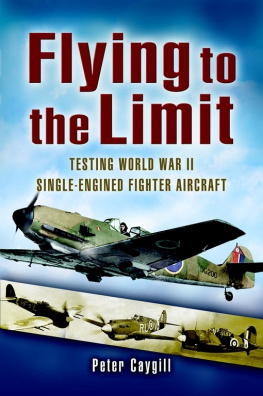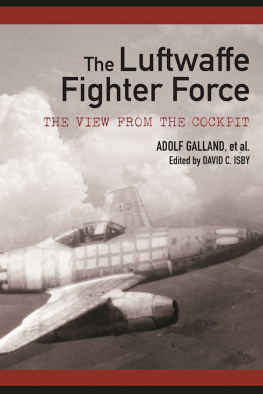
First published in Great Britain in 2011 by
Pen & Sword Aviation
an imprint of
Pen & Sword Books Ltd
47 Church Street
Barnsley
South Yorkshire
S70 2AS
Copyright Peter Caygill 2011
9781844685912
The right of Peter Caygill to be identified as Author of this Work
has been asserted by him in accordance with the Copyright, Designs
and Patents Act 1988.
A CIP catalogue record for this book is
available from the British Library.
All rights reserved. No part of this book may be reproduced or
transmitted in any form or by any means, electronic or mechanical
including photocopying, recording or by any information storage and
retrieval system, without permission from the Publisher in writing.
Typeset in 12/13.5pt Palatino by
Concept, Huddersfield, West Yorkshire
Printed and bound in England by
CPI Group (UK) Ltd, Croydon, CRO 4YY
Pen & Sword Books Ltd incorporates the Imprints of Pen & Sword
Aviation, Pen & Sword Family History, Pen & Sword Maritime, Pen &
Sword Military, Pen & Sword Discovery, Wharncliffe Local History,
Wharncliffe True Crime, Wharncliffe Transport, Pen & Sword Select,
Pen & Sword Military Classics, Leo Cooper, The Praetorian Press,
Remember When, Seaforth Publishing and Frontline Publishing.
For a complete list of Pen & Sword titles please contact
PEN & SWORD BOOKS LIMITED
47 Church Street, Barnsley, South Yorkshire, S70 2AS, England
E-mail: enquiries@pen-and-sword.co.uk
Website: www.pen-and-sword.co.uk
Acknowledgements
Much of the research for this book was carried out at the National Archives at Kew, in particular flight trials reports on the various marks of Javelin as conducted by A&AEE Boscombe Down and AWDS at West Raynham. I also looked at relevant RAF squadron records and accident reports and would like to thank the staff at TNA not only for their help, but their extremely efficient service in delivering the documents that provided much of the information for this work.
This book could not have been written without the enthusiastic support of a number of former Javelin pilots and navigators and I am deeply indebted to them. Their testimonies provide a fascinating insight into the Javelin and RAF squadron life in the 1950s and 1960s. In alphabetical order they are as follows : Paul Burns (60 and 29 Squadrons), Fred Butcher (23 and 60 Squadrons), Noel Davies (AWDS), Colin Edwards (46 and 60 Squadrons), Howard Fitzer (46 and 23 Squadrons), Paddy Harbison (29 Squadron), Don Headley (64 Squadron), Paul Hodgson (89 Squadron), the late Ivan Logan (23 Squadron), Mike Miller (23 and 60 Squadrons), Hank Prosser (41 Squadron), Jim Sawyer (33 Squadron), Gerry Shipley (23 and 60 Squadrons), Bruce Spurr (228 OCU), Pete Thorn (23 and 29 Squadrons), Tony Warner (46 Squadron) and Guy Woods (151 and 25 Squadrons).
JAVELIN FROM THE COCKPIT
I would also like to thank Bob Hillard who was a ferry pilot with 187 Squadron and flew the very first Javelin FAW.1 to enter RAF squadron service, and Peter Hicks who was involved in a mid-air collision with a Javelin when flying a Hawker Hunter of the Central Flying School.
The photographs in this book came from a variety of sources and in particular I would like to thank Philip Jarrett, Howard Fitzer, Mike Miller and Colin Edwards for their help in supplying suitable images.
Finally I would like to thank Peter Coles and the production staff at Pen and Sword for their help and assistance with this project.
Peter Caygill
Darlington
Introduction
During its time in RAF service the Gloster Javelin acquired a few nicknames, most of them uncomplimentary. The inspiration for these names is fairly obvious, Flatiron was a commentary on the shape of its delta wing and the term Dragmaster came about as a result of its size and proportion, in particular its thick wing. The Javelin was an imposing aircraft especially for those RAF pilots who had made the transition from day fighters to all-weather fighters and had swapped the beautiful lines and crisp handling of the Hawker Hunter for something that on first acquaintance looked more like a bomber. For pilots and navigators who were already flying in night-fighter squadrons the Javelin was warmly welcomed as a being huge advance in performance and capability when compared to the Meteors and Venoms that they had been used to.
The Javelin had a troubled gestation and did not enter RAF squadron service until 1956 which was roughly ten years after the initial requirement had been formulated. It was effectively a bomber-destroyer and was designed to operate against Soviet bombers armed with nuclear weapons. In the event of a nuclear conflict it was assumed that aircraft such as the Tupolev Tu-16 Badger would be deployed against the UK in mass raids and it was the job of the Javelin crews to intercept and destroy these aircraft as far from the UK coast as possible. The early marks of Javelin were armed with four 30 mm Aden cannon, however later marks introduced the Firestreak air-to-air missile which provided a quantum leap in operational capability. Although the early Javelins were considered by some to be under-powered, the later Javelins also had more powerful Sapphire engines which boosted performance and allowed interceptions to be made up to 50,000 ft
The Javelin was the RAFs principal night/all-weather fighter until the advent of the English Electric Lightning, but once its Cold War duties were over it provided a valuable contribution in various trouble-spots throughout the world, in particular the Indonesian-Malaysian Confrontation in the Far East. It also provided a much-needed British presence in the Mediterranean with regular detachments to Cyprus. From March 1963 No. 29 Squadron was based at Nicosia before moving to Akrotiri and it was from here that ten aircraft detached to Zambia to provide air-support following Rhodesias Unilateral Declaration of Independence in November 1965.
Although it did not inspire the affection of the Hunter, the Javelin was well-liked in service and did everything that was asked of it. Over the years it has become something of an unsung hero and this book attempts to redress the balance. The story of the Javelin is told from the crews point of view, both from information derived from flight trials reports by the test establishments at Boscombe Down and West Raynham and numerous first-hand accounts by pilots and navigators. Their testimonies show that the Javelin was an able performer and was developed into a first-rate weapons system.
CHAPTER 1
Design and Development
The Gloster GA.5 (later to be called Javelin) was flown for the first time on 26 November 1951 by Gloster Chief Test Pilot S/L W.A. Bill Waterton AFC, the flight marking the end of a protracted gestation which can be traced back to the end of the Second World War. With the fall of Germany in 1945 there was a race between the victorious Allied nations to discover its secrets, in which particular emphasis was placed on acquiring information relating to Germanys advanced aircraft projects. The discovery of radical new shapes for aircraft and associated aerodynamic data was to have a profound effect on the design of what would become the Javelin.
In the period immediately after the Second World War the night skies over Britain were patrolled by night-fighter versions of the de Havilland Mosquito which was equipped with the American-manufactured centimetric-wave AI.10 radar. Although one of the classic designs of the war, the pace of aeronautical development in the immediate post war years was such that the Mosquito quickly became obsolescent. Existing long-range bombers such as the Boeing B-29 Superfortress (soon to be cloned by the Soviet Union as the Tupolev Tu-4) were capable of cruising at speeds of around 300 mph at altitudes of 35,000 ft, and in the near future there was the prospect of jet bombers entering service with much greater performance. In the face of such a potential threat it was clear that Britains air defences, both day and night, needed a radical transformation and a number of specifications were issued by the Air Ministry.


